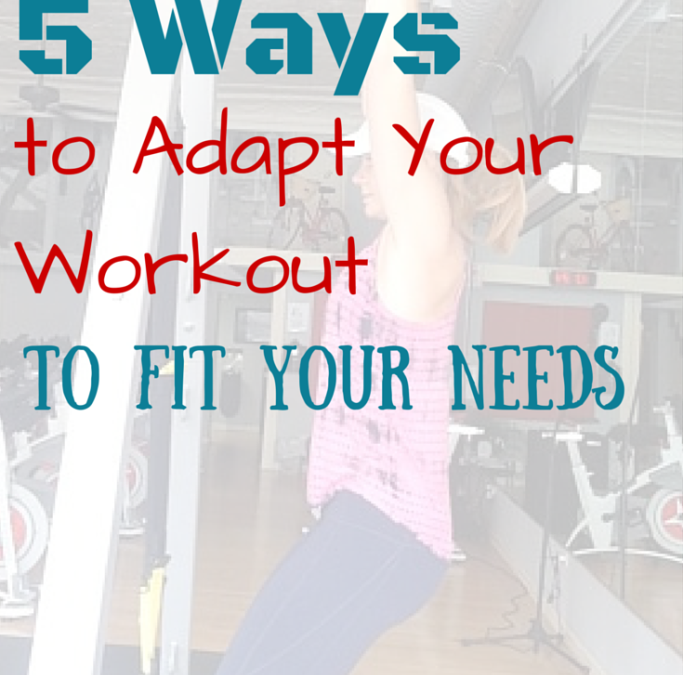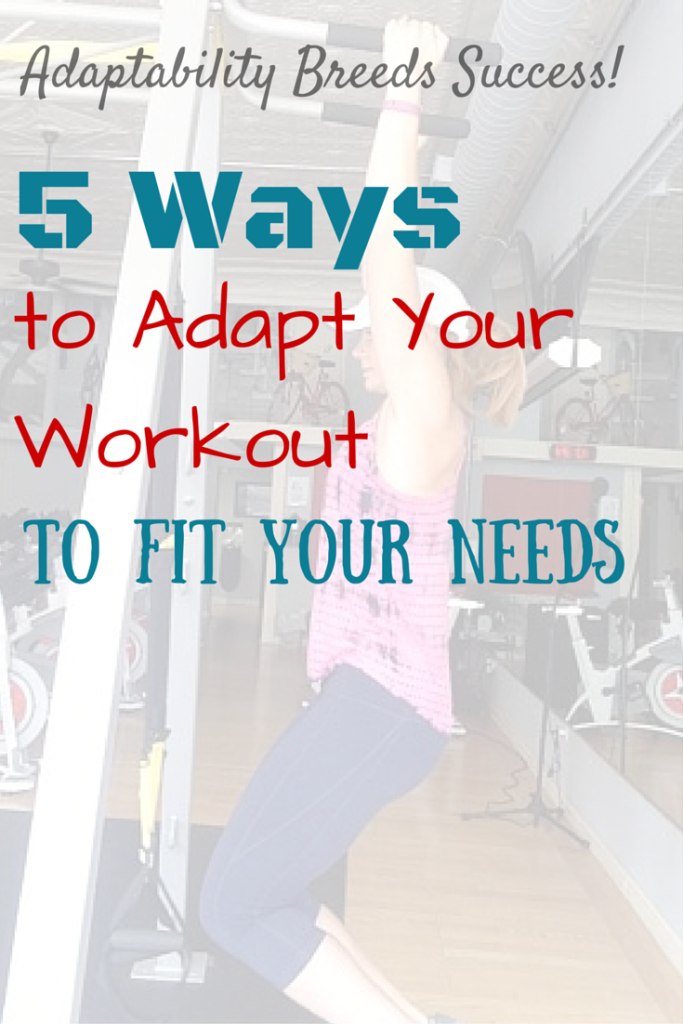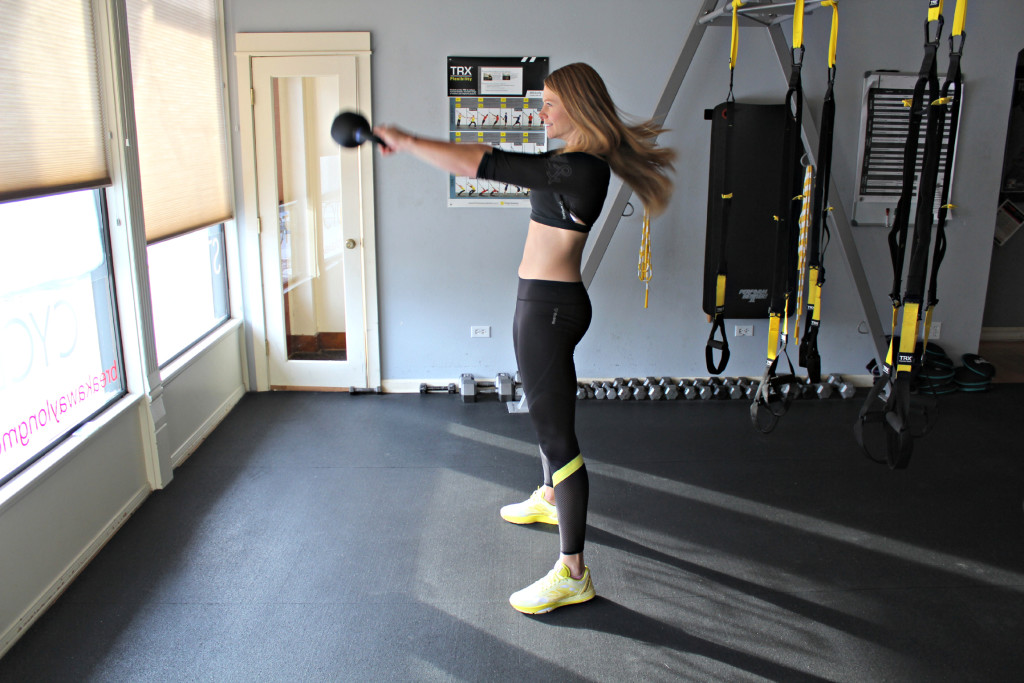Some thoughts and discussions from me.
[Tweet “5 Ways to be Adaptable for a Successful Workout via @TrainerPaige #fitfluential”]
We’ve all been there – especially at this time of year: you’re in the gym, with your workout program in hand (or on iPhone screen,) pumped to crush the workout your trainer wrote for you. You saunter up to the squat rack, ready to bust out those back squats…and the squat racks are full. With a line.
What do you do? Put your iPhone in your locker and do some cardio instead? Get frustrated, and abort your workout altogether? OR maybe you let out a sigh, realize it’s not a big deal, and rely on your adaptable attitude and knowledge for how to adapt your workout.
I like that last answer the best;-) In fact, it happens to me almost every time I’m in the gym!
Reasons to Adapt
While taken equipment is probably the most common reason to make sure you’re adaptable in your workouts, it’s not the only reason. Anything from a poor night’s sleep, to a nagging pain, to an exercise that just doesn’t feel right can be reason to adapt and scale down your workout.
Conversely, you might want to adapt and bump up the intensity if you had a great night sleep, an extra couple of rest days, or are just feeling like a supa star!
Whatever the reason, there are few workouts that will go 100% as planned and exactly as we want them to – unless that is, you have access to your own private gym with every piece of equipment you could desire. This means one thing: adaptability is KEY for success.
Adaptability is Key for Success
I want you to assume every workout written for you or you’re going to do is a best case scenario situation. It’s important to realize that schtuff happens, and your best chance at consistency, progress, and success is to be adaptable. For my online clients, I write out their programs based on the equipment they have access to, but also offer up suggestions for adaptations of the same “movement” when they aren’t able to follow the workout as written.
With my in-person clients, I’ve become very skilled over the years at coming up with an alternative exercise on the fly if equipment is taken, or the movement just isn’t working for them. It’s part of completing a successful program and avoiding burn out in the process.
It’s so important, that I wanted to share with you 5 common scenarios in which you can be adaptable in your workout.
5 Ways to Adapt Your Workout to Fit Your Needs
Be adaptable with…
1. Lifting Equipment
The most common adaptable scenario at my studio is the squat rack being taken. If I’m planning on doing squats, the simplest substitution is to use dumbbells or kettlebells for my squat exercises. It won’t likely won’t mimic what I’m going for exactly (more on that below) but it’s a fair substitution.
Here are some other equipment and exercise substitutions I find myself using with my clients’ and my own workouts in the gym:
- Dumbbells (for swings, pushes, cleans, squats, carries, lunges, etc.) for Kettlebells
- Medicine Ball (for slams, throws) for Battling Ropes
- Resistance bands for Cable Machines – (I love my resistance bands! See total body resistance workout, upper body band workout, and lower body band workout – plus some on IG)
- Plates on a towel (for plate pushes) for Prowlers
- Trap/Hex Bar (for deadlifts) for Olympic Barbell
- Weight Plates (for hip thrusts, carries, lifts, etc.) for Barbells or Dumbbells
- Smith Machine (for inverted rows) for TRX
- And one time I got really creative, and used a bed sheet for TRX inverted rows!
2. Reps, Sets, and Tempo
Clearly, 2 dumbbells won’t always get you the same affect as a barbell. If I’d been planning on doing 5 sets of 3 back squats, chances are I’d have been squatting with a very heavy load. That’s a difficult situation to replicate! Instead of trying to front squat with two 80# dumbbells, I’d change up my volume and tempo. To increase the work load, I’d add a few reps, and slow down my tempo, possibly even by adding a pause at the bottom.
3. Cardio Machines
Aside from hill sprints and teaching indoor cycling (aka the revolving staircase of hell) most of my conditioning workouts are done through lifting weights. By lifting weights (or just your own body weight) with a moderate load, a dash of power, and a sped up tempo, you can get a killer cardio workout. Plus, you’re building strength at the same time. It’s a win-win!
In fact, some of my clients never step foot on a treadmill for their cardio. For my RESOLVE group coaching group, my girls have a choice of traditional interval cardio, or one of my metabolic workouts.
Below are a few of my favorite metabolic/cardio strength exercises:
- Battling ropes
- Medicine ball slams
- Kettlebell swings
- Push presses
- Plyo step ups
- Plyo lunges
Plus many, many more. I also post cardio strength workouts on my Instagram channel all the time.
4. Pains/injuries
I often begin training a client who has been sedentary for the past 6, 12, 18 months because of an injury. Maybe they hurt their shoulder doing an intense, not-very safe type of workout, and then gave up exercise altogether while it healed.
The thing is: you don’t have to stop exercising altogether if something hurts! I deal with a nagging shoulder pain at the biceps attachment from a very old volleyball injury. When that flares up, I don’t take a break from the gym. I simply do what doesn’t bother it. Mainly, I work on lower body a lot.
The same thing with a lower body injury. This is trickier, because then people tend to think they aren’t able to do cardio at all. However, depending on the injury, certain types of exercise are ok, if not encouraged!
If the lower body is out of commission, there are still upper-body dominant forms of conditioning like medicine ball slams, battling ropes, and tosses.
Have a sudden burst of energy when you hit the gym and want to push the intensity a little bit? There are ways you can intensity your workout – and not by simply making it longer. You can read more about exercise progressions in this post.
Additionally, if your energy levels are down, there’s no reason why taking an extra rest day shouldn’t be an option.
5. Travel
Another life situation that tends to get in the way of our workout routines, is travel, but it doesn’t have to either! Many hotels have great gyms – and even not so great gyms – that will suffice for your workout just fine. However, even if where you’re traveling doesn’t have a gym, there are still other options.
One of my very favorite travel tools is the resistance band. Wherever I go, I throw a medium and heavy-resistance band (I like the full loop ones) in my suitcase, which takes up barely any room at all. You can substitute almost any exercise with a resistance band exercise.
[Tweet “5 Ways to Adapt Your Workout to Fit Your Needs via @TrainerPaige #fitfluential”]
Should you try and stick to the program as much as possible? Yes – it’s written the way it’s written for a reason (provided you’re following a well-constructed, progressive program.) However, life gets in the way, and just as we do with every other aspect of life, we have to roll with the changes. Don’t beat yourself up. Just be adaptable.
How do you adapt your workouts when they don’t go as planned?
[efb_likebox fanpage_url=”yourtrainerpaige” box_width=”250″ box_height=”” colorscheme=”light” locale=”en_US” responsive=”0″ show_faces=”1″ show_header=”1″ show_stream=”0″ show_border=”1″ ]






Great suggestions! You really do have to have a back up especially when the gym is busy or equipment goes missing. When I first starting working out I would be completely thrown off, but now I know I can substitute another exercise and get the same effect.
Lauren @ The Bikini Experiment recently posted…Benefits of Probiotics
These are some great tips. It’s easy to get frustrated, especially with injuries. I’ve been having to modify my yoga practice lately because my wrists have been giving me trouble. Finding other kinds of workouts besides yoga has been awesome.
Fiona @ Get Fit Fiona recently posted…7 Snacks to Eat on the Go